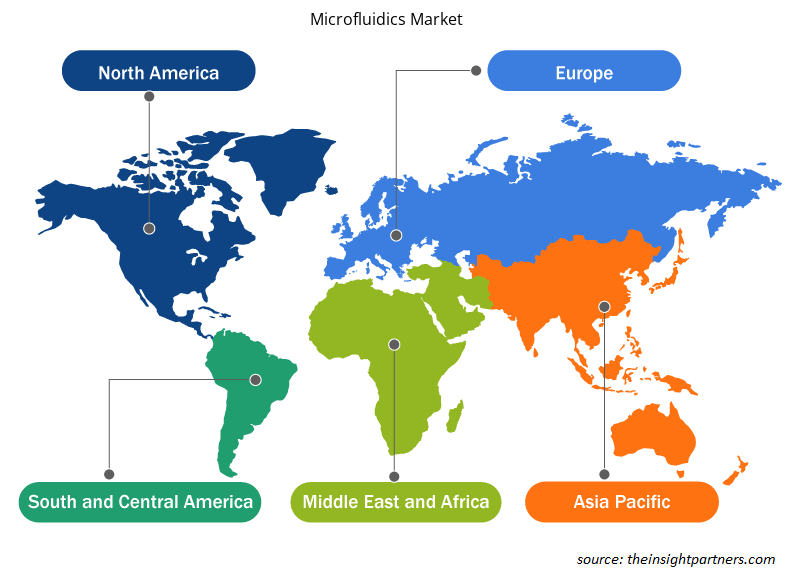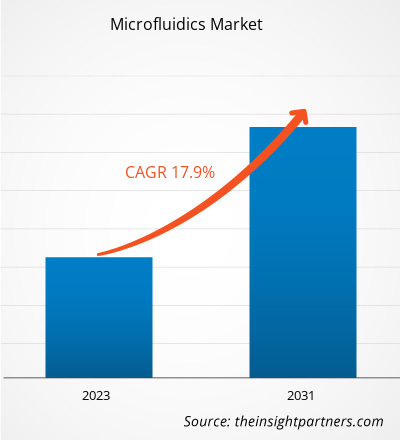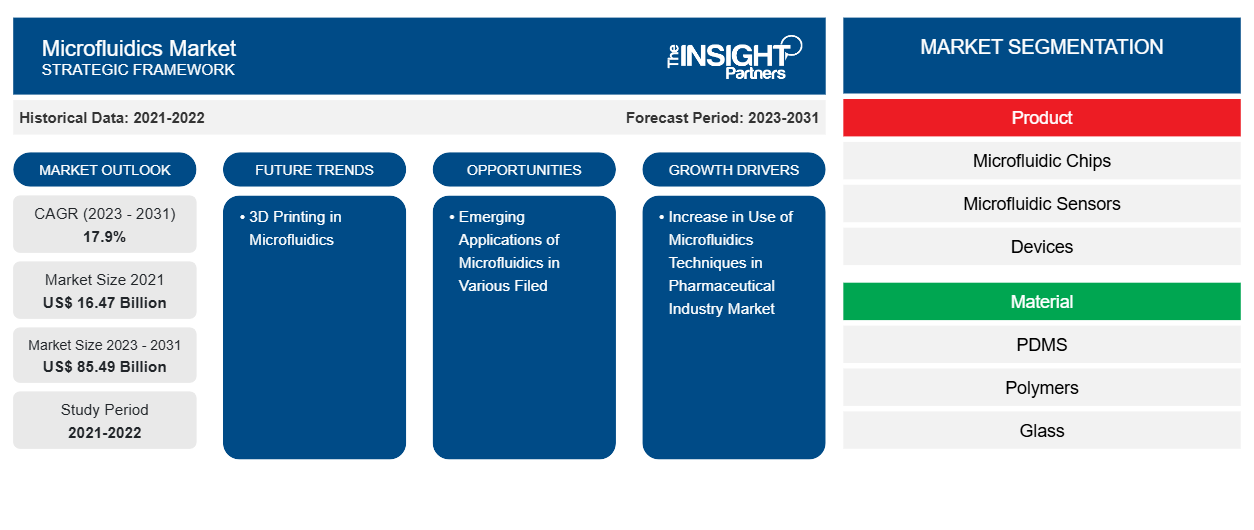2021 年微流体市场价值为 164.7 亿美元,预计到 2031 年将达到 854.9 亿美元。预计 2023-2031 年市场复合年增长率为 17.9%。微流体 3D 打印可能仍将是市场的主要趋势。
微流体市场分析
由于生物技术、医学和医疗保健应用,微流控市场正在迅速扩张。微型化、自动化和高通量能力是重要组成部分。市场参与者包括成熟企业和在即时检测、药物输送和诊断等领域开拓的初创企业。北美和欧洲是领先的地区,因为它们在研究方面拥有强大的投资和基础设施。与其他技术(如人工智能和物联网)集成以提高功能和效率是市场新兴趋势之一。
微流体市场概况
微流体技术包括两个研究领域:微通道中流体行为的科学和生产微型设备的技术,微型设备带有用于流体流动或限制的通道和腔室。微流体技术领域处理的流体体积小至飞升 (fL),即千万亿分之一升。在微米尺度上,流体的行为与现实世界中的流体截然不同。这些特性对于新的科学发现和实验至关重要。如今,微流体技术为各种研究领域,尤其是生物分析提供了有效的工具。为最终用户简化和集成完整的生物过程,具有高通量、多路复用和高并行性的分析,由于反应和分离时间缩短,分析速度更快,便携式工具可用于即时护理环境,试剂使用量最少,每次分析的总体成本降低,微流体技术可实现精确测量。它提高了特定应用中的测量分辨率等,这些都是微流体技术提供的优势。这可能导致对微流体的需求增加,从而促进市场增长。
定制此报告以满足您的需求
您可以免费定制任何报告,包括本报告的部分内容、国家级分析、Excel 数据包,以及为初创企业和大学提供优惠和折扣
-
获取此报告的关键市场趋势。这个免费样品将包括数据分析,从市场趋势到估计和预测。
微流体市场驱动因素和机遇
微流体技术在制药行业市场的应用增加
制药行业已将大量微流控工艺融入个性化医疗,以寻找和提供新型药物。微流控设备可以加速该过程的多个阶段,例如目标选择、临床试验、化学合成、配方研究和产品管理。鉴于药物研发成本高昂,这些发展最终可能会帮助消费者并推动市场增长。
微流体在各个领域的新兴应用——微流体市场的机遇
在学术研究中,微流体技术仍然是工程师和细胞生物学家合作的跨学科领域。这些合作的目标是不断改进细胞培养实验。相反,生物医学领域现在才开始大量利用微流体技术。微流体设备已用于研究和创造新型治疗药物和医学诊断方面的几项重大进展。例如,对于简单的血液测试,使用微流体设备需要更少的血液并显着加快处理时间。研发团队也在使用微流体技术来测试新药物。因此,微流体技术应用的增加可能会在市场上创造充足的机会。
微流体市场报告细分分析
有助于微流体市场分析的关键部分是产品、技术、材料和应用。
- 根据治疗类型,产品市场分为微流控芯片、微流控传感器、设备、微泵、微针、其他产品。设备部分在 2023 年占据了更大的市场份额。
- 根据材料,市场分为 PDMS、聚合物、玻璃、硅、其他材料。PDMS 部分在 2023 年占据了最大的市场份额。
- 根据应用,市场分为体外诊断、制药和生命科学研究、药物发现、其他应用。体外诊断领域在 2023 年占据了最大的市场份额。
微流控市场份额按地区分析
微流体市场报告的地理范围分为五个区域:北美、亚太、欧洲、中东和非洲、南美/南美和中美。
北美占据了微流控市场的主导地位。在北美,美国是 2023 年最大的微流控市场。该地区的市场初步受到研发活动增加、技术进步的早期采用以及主要参与者的大量投资的推动。例如,2021 年 5 月,正在开发酶蛋白和基因合成技术的快速扩张的生物技术企业 Nuclear 和电子墨水技术行业先驱 E Ink 宣布,E Ink 的数字微流控部门已被新成立的美国子公司 Nuclera 收购。
微流体市场区域洞察
Insight Partners 的分析师已详细解释了预测期内影响微流控市场的区域趋势和因素。本节还讨论了北美、欧洲、亚太地区、中东和非洲以及南美和中美洲的微流控市场细分和地理位置。

- 获取微流体市场的区域特定数据
微流体市场报告范围
| 报告属性 | 细节 |
|---|---|
| 2021 年市场规模 | 164.7亿美元 |
| 2031 年市场规模 | 854.9亿美元 |
| 全球复合年增长率(2023 - 2031) | 17.9% |
| 史料 | 2021-2022 |
| 预测期 | 2023-2031 |
| 涵盖的领域 |
按产品
|
| 覆盖地区和国家 |
北美
|
| 市场领导者和主要公司简介 |
|
微流体市场参与者密度:了解其对业务动态的影响
微流控市场正在快速增长,这得益于终端用户需求的不断增长,而这些需求又源于消费者偏好的不断变化、技术进步以及对产品优势的认识不断提高等因素。随着需求的增加,企业正在扩大其产品范围,进行创新以满足消费者的需求,并利用新兴趋势,从而进一步推动市场增长。
市场参与者密度是指在特定市场或行业内运营的企业或公司的分布情况。它表明在给定市场空间中,相对于其规模或总市场价值,有多少竞争对手(市场参与者)存在。
在微流体市场运营的主要公司有:
- 安捷伦科技公司
- 屋宇署
- Bio-Rad 实验室公司
- 丹纳赫
- Dolomite Microfluidics(Blacktrace Holdings Ltd.)
- Fludigm 公司
免责声明:上面列出的公司没有按照任何特定顺序排列。

- 了解微流体市场主要参与者概况
微流体市场新闻和最新发展
微流体市场通过收集一级和二级研究后的定性和定量数据进行评估,其中包括重要的公司出版物、协会数据和数据库。以下是微流体市场的发展和策略列表:
- CellFE Inc. 是一家创新型微流控公司,致力于改变先进细胞疗法的开发和制造,该公司宣布其 Infinity Mtx 细胞工程平台已投入商业使用,该平台利用快速细胞压缩和再膨胀将目标有效载荷主动运送到细胞中。CellFE 微流控细胞工程平台的优势包括高产量的编辑细胞、缩短的细胞恢复和膨胀时间以及高效吸收各种有效载荷,从而缩短静脉到静脉的时间并降低制造成本。(来源:CellFE Inc 公司名称,新闻稿,2023 年)
- 连接器和传感器领域的全球领导者 TE Connectivity 已收购三家专注于微流体盒和泡罩试剂包装开发、可用性测试、临床研究和制造的公司。(来源:TE Connectivity 公司名称,简报,2021 年)
微流体市场报告覆盖范围和交付成果
“微流体市场规模和预测(2021-2031)”报告对以下领域进行了详细的市场分析:
- 范围内涵盖的所有主要细分市场的全球、区域和国家层面的市场规模和预测
- 市场动态,如驱动因素、限制因素和关键机遇
- 未来主要趋势
- 详细的 PEST/波特五力分析和 SWOT 分析
- 全球和区域市场分析涵盖关键市场趋势、主要参与者、法规和最新市场发展
- 行业格局和竞争分析,涵盖市场集中度、热点图分析、知名参与者和最新发展
- 详细的公司简介
- 历史分析(2 年)、基准年、预测(7 年)及复合年增长率
- PEST和SWOT分析
- 市场规模、价值/数量 - 全球、区域、国家
- 行业和竞争格局
- Excel 数据集
近期报告
客户评价
购买理由
- 明智的决策
- 了解市场动态
- 竞争分析
- 客户洞察
- 市场预测
- 风险规避
- 战略规划
- 投资论证
- 识别新兴市场
- 优化营销策略
- 提升运营效率
- 顺应监管趋势























 获取免费样品 - 微流体市场
获取免费样品 - 微流体市场